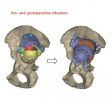(Press-News.org) Over the past three years, researchers in the Camera Culture group at the MIT Media Lab have steadily refined a design for a glasses-free, multiperspective, 3-D video screen, which they hope could provide a cheaper, more practical alternative to holographic video in the short term.
Now they've designed a projector that exploits the same technology, which they'll unveil at this year's Siggraph, the major conference in computer graphics. The projector can also improve the resolution and contrast of conventional video, which could make it an attractive transitional technology as content producers gradually learn to harness the potential of multiperspective 3-D.
Multiperspective 3-D differs from the stereoscopic 3-D now common in movie theaters in that the depicted objects disclose new perspectives as the viewer moves about them, just as real objects would. This means it might have applications in areas like collaborative design and medical imaging, as well as entertainment.
The MIT researchers — research scientist Gordon Wetzstein, graduate student Matthew Hirsch, and Ramesh Raskar, the NEC Career Development Associate Professor of Media Arts and Sciences and head of the Camera Culture group — built a prototype of their system using off-the-shelf components. The heart of the projector is a pair of liquid-crystal modulators — which are like tiny liquid-crystal displays (LCDs) — positioned between the light source and the lens. Patterns of light and dark on the first modulator effectively turn it into a bank of slightly angled light emitters — that is, light passing through it reaches the second modulator only at particular angles. The combinations of the patterns displayed by the two modulators thus ensure that the viewer will see slightly different images from different angles.
The researchers also built a prototype of a new type of screen that widens the angle from which their projector's images can be viewed. The screen combines two lenticular lenses — the type of striated transparent sheets used to create crude 3-D effects in, say, old children's books.
Exploiting redundancy
For every frame of video, each modulator displays six different patterns, which together produce eight different viewing angles: At high enough display rates, the human visual system will automatically combine information from different images. The modulators can refresh their patterns at 240 hertz, or 240 times a second, so even at six patterns per frame, the system could play video at a rate of 40 hertz, which, while below the refresh rate common in today's TVs, is still higher than the 24 frames per second standard in film.
With the technology that has historically been used to produce glasses-free 3-D images — known as a parallax barrier — simultaneously projecting eight different viewing angles would mean allotting each angle one-eighth of the light emitted by the projector, which would make for a dim movie. But like the researchers' prototype monitors, the projector takes advantage of the fact that, as you move around an object, most of the visual change takes place at the edges. If, for instance, you were looking at a blue mailbox as you walked past it, from one step to the next, much of your visual field would be taken up by a blue of approximately the same shade, even though different objects were coming into view behind it.
Algorithmically, the key to the researchers' system is a technique for calculating how much information can be preserved between viewing angles and how much needs to be varied. Preserving as much information as possible enables the projector to produce a brighter image. The resulting set of light angles and intensities then has to be encoded into the patterns displayed by the modulators. That's a tall computational order, but by tailoring their algorithm to the architecture of the graphics processing units designed for video games, the MIT researchers have gotten it to run almost in real time. Their system can receive data in the form of eight images per frame of video and translate it into modulator patterns with very little lag.
Bridge technology
Passing light through two modulators can also heighten the contrast of ordinary 2-D video. One of the problems with LCD screens is that they don't enable "true black": A little light always leaks through even the darkest regions of the display. "Normally you have contrast of, let's say, values between 0 and 1," Wetzstein explains. "That's the full contrast, but in practice, all modulators have something like 0.1 to 1. So you get this 'black level.' But if you multiply two optically together, the black level goes down to 0.01. If you show black on one, which is 10 percent, and black on the other, which is also 10 percent, what you get through is 1 percent. So it's much more black."
By the same token, Hirsch explains, if the patterns displayed on the modulators are slightly offset from each other, the light passing through them will interfere with itself in ways that actually heighten the resolution of the resulting images. Again, the researchers have developed an algorithm that can calculate those patterns on the fly.
As content creators move to so-called "quad HD," video with four times the resolution of today's high-definition video, the combination of higher contrast and higher resolution could make a commercial version of the researchers' technology appealing to theater owners, which in turn could smooth the way for the adoption of multiperspective 3-D. "One thing you could do — and this is what actual projector manufacturers have done in the recent past — is take four 1080p modulators and put them next to each other and build some very complicated optics to tile them all seamlessly and then get a much nicer lens because you have to project a much smaller spot and bundle that all up together," Hirsch says. "We're saying you could take two 1080p modulators, stick them in your projector one after the other, then take your same old 1080p lens and project through it and use this software algorithm, and you end up with a 4k image. But not only that, it's got even higher contrast."
INFORMATION:
Written by Larry Hardesty, MIT News Office
Additional background
ARCHIVE: Glasses-free 3-D TV looks nearer http://newsoffice.mit.edu/2012/glasses-free-3d-television-0712
ARCHIVE: Better glasses-free 3-D http://newsoffice.mit.edu/2011/glasses-free-3d-0504
ARCHIVE: In Profile: Ramesh Raskar http://newsoffice.mit.edu/2011/profile-raskar-0929
Glasses-free 3-D projector
New design could also make conventional 2-D video higher in resolution and contrast
2014-05-16
ELSE PRESS RELEASES FROM THIS DATE:
Growing camelina and safflower in the Pacific Northwest
2014-05-16
A recent study published in Agronomy Journal provides information important to farmers growing oilseed crops. In the study, camelina and safflower were grown in three-year rotations with winter wheat and summer fallow. The study shows that using this rotation may require that no tillage should be done to the soil during the fallow year. Oilseed crops produce relatively little residue—organic material such as roots that hold the soil together. Even light tillage can disintegrate the soil.
A cooperative study by the USDA-ARS and Washington State University researched the ...
How Asian American 'tiger mothers' motivate their children
2014-05-16
An article titled "Why Chinese Mothers Are Superior," published in The Wall Street Journal in 2011, has continued to provoke a cultural debate among parents after self-proclaimed 'tiger mother' Amy Chua asserted that Asian American parenting methods produce more successful children. Researchers at Stanford University delved deeper into Chua's 'tiger mother' approach, and their research sheds light on key fundamental differences in parenting methods between Asian Americans and European Americans.
To reveal the cultural differences in parenting, the researchers compare ...
Ground breaking hip and stem cell surgery in Southampton
2014-05-16
Doctors and scientists in Southampton have completed their first hip surgery with a 3D printed implant and bone stem cell graft.
The 3D printed hip, made from titanium, was designed using the patient's CT scan and CAD CAM (computer aided design and computer aided manufacturing) technology, meaning it was designed to the patient's exact specifications and measurements.
The implant will provide a new socket for the ball of the femur bone to enter. Behind the implant and between the pelvis, doctors have inserted a graft containing bone stem cells.
The graft acts as ...
Fires continue in San Diego County, California
2014-05-16
Seven fires are still burning in San Diego County, California. Arson is suspected as the origin of these fires. Two teens have been arrested on suspicion of setting the fire that spread so ferociously across the county. All of California is experiencing exceptional, extreme or severe drought conditions. The wildfire area is in the second-most dangerous category--extreme drought conditions. California's governor has cited climate change as a factor in the fires, noting the last three years have been the driest in recorded history. Wildfire season used to start in late ...
Skunk fire in Arizona
2014-05-16
The Skunk Fire in Arizona started with a lightning strike on Saturday, April 19. Currently over 10,000 acres have been affected. It is located in the San Carlos Apache Reservation. The terrain in the area is very steep with boulders making it difficult for firefighters to traverse the area to fight the fire. The fire continues to grow to the north, but fire activity in the south has been stopped. The fire is currently 20% contained.
The National Weather Service is forecasting winds of 7-12 mph with gusting to 25 mph. These conditions coupled with extremely dry fuels ...
Cause of death established
2014-05-16
Chamois (Rupicapra rupicapra) share their habitat with a number of other wild animals as well as with farm animals. Because of the risk of disease transmission between species, when dead or sick animals are discovered by hunters or foresters it is extremely important determining the causes. Early identification of the cause of disease or death can be crucial to prevent a wide-scale outbreak. The Pathological Laboratory at the Research Institute of Wildlife Ecology specializes in such cases.
Severe pneumonia as cause of death
Nineteen dead chamois from the region of ...
Fast and curious: Electrons hurtle into the interior of a new class of quantum materials
2014-05-16
As smartphones get smarter and computers compute faster, researchers actively search for ways to speed up the processing of information. Now, scientists at Princeton University have made a step forward in developing a new class of materials that could be used in future technologies.
They have discovered a new quantum effect that enables electrons — the negative-charge-carrying particles that make today's electronic devices possible — to dash through the interior of these materials with very little resistance.
The discovery is the latest chapter in the story of a curious ...
Researchers call for better ocean stewardship
2014-05-16
FORT LAUDERDALE-DAVIE, Fla. – It has been said that we know more about the surface of the moon than we do about our own planet's oceans. That especially applies to the deepest parts of our oceans – depths that are 200 meters or deeper.
Researchers from organizations around the world who specialize in studying and exploring the deepest regions of our oceans have come together to pen a cautionary tale that urges we take a critical look at how we're treating our seas.
"We need to consider the common heritage of mankind - when do we have the right to take something that ...
Molecules involved in rheumatoid arthritis angiogenesis identified
2014-05-16
Two protein molecules that fit together as lock and key seem to promote the abnormal formation of blood vessels in joints affected by rheumatoid arthritis, according to researchers at the University of Illinois at Chicago College of Medicine, who found that the substances are present at higher levels in the joints of patients affected by the disease.
Their results are reported in the journal Annals of the Rheumatic Diseases.
"Our results show, for the first time, that these two proteins – a receptor and its corresponding binding protein - play a key role in the progression ...
US foreclosures drive up suicide rate
2014-05-16
HANOVER, N.H. – May 16, 2014 – The recent U.S. foreclosure crisis contributed significantly to the nation's jump in suicides, independent of other economic factors associated with the Great Recession, according to a study by Dartmouth and Purdue professors publishing Monday.
The study, publishing in the June issue of the American Journal of Public Health and available online now, is the first to ever show a correlation between foreclosure and suicide rates.
The authors analyzed state-level foreclosure and suicide rates from 2005 to 2010. During that period, the U.S. ...
LAST 30 PRESS RELEASES:
Numbers in our sights affect how we perceive space
SIMJ announces global collaborative book project in commemoration of its 75th anniversary
Air pollution exposure and birth weight
Obstructive sleep apnea risk and mental health conditions among older adults
How talking slows eye movements behind the wheel
The Ceramic Society of Japan’s Oxoate Ceramics Research Association launches new international book project
Heart-brain connection: international study reveals the role of the vagus nerve in keeping the heart young
Researchers identify Rb1 as a predictive biomarker for a new therapeutic strategy in some breast cancers
Survey reveals ethical gaps slowing AI adoption in pediatric surgery
Stimulant ADHD medications work differently than thought
AI overestimates how smart people are, according to HSE economists
HSE researchers create genome-wide map of quadruplexes
Scientists boost cell "powerhouses" to burn more calories
Automatic label checking: The missing step in making reliable medical AI
Low daily alcohol intake linked to 50% heightened mouth cancer risk in India
American Meteorological Society announces Rick Spinrad as 2026 President-Elect
Biomass-based carbon capture spotlighted in newly released global climate webinar recording
Illuminating invisible nano pollutants: advanced bioimaging tracks the full journey of emerging nanoscale contaminants in living systems
How does age affect recovery from spinal cord injury?
Novel AI tool offers prognosis for patients with head and neck cancer
Fathers’ microplastic exposure tied to their children’s metabolic problems
Research validates laboratory model for studying high-grade serous ovarian cancer
SIR 2026 delivers transformative breakthroughs in minimally invasive medicine to improve patient care
Stem Cell Reports most downloaded papers of 2025 highlight the breadth and impact of stem cell research
Oxford-led study estimates NHS spends around 3% of its primary and secondary care budget on the health impacts of heat and cold in England
A researcher’s long quest leads to a smart composite breakthrough
Urban wild bees act as “microbial sensors” of city health.
New study finds where you live affects recovery after a hip fracture
Forecasting the impact of fully automated vehicle adoption on US road traffic injuries
Alcohol-related hospitalizations from 2016 to 2022
[Press-News.org] Glasses-free 3-D projectorNew design could also make conventional 2-D video higher in resolution and contrast






